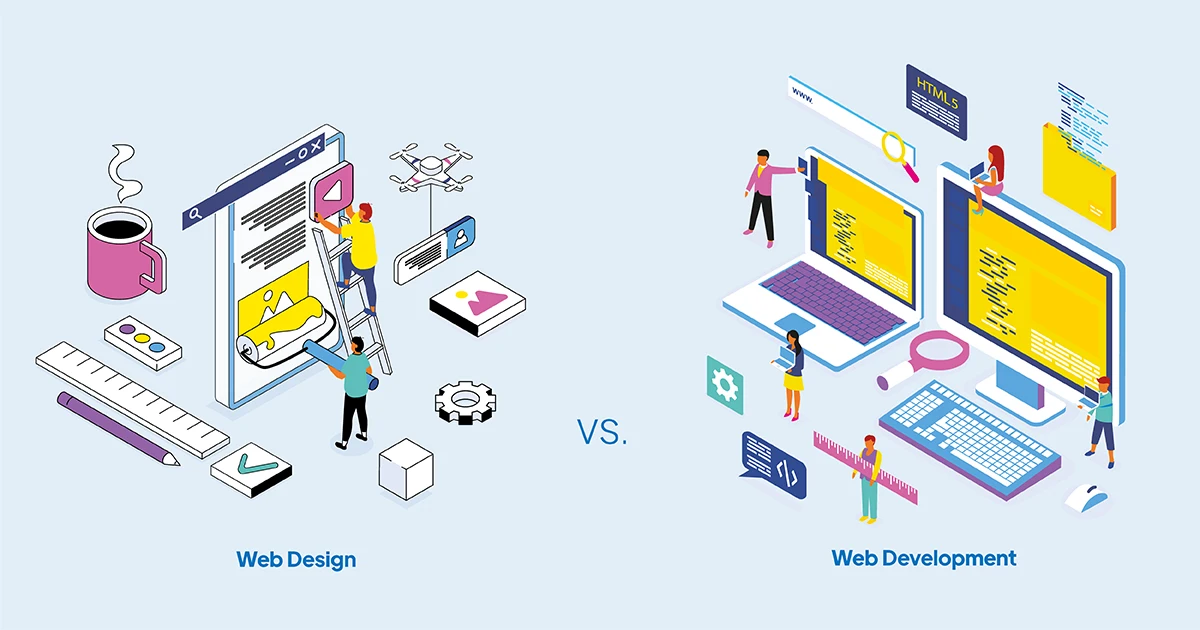Once upon a time, in the bustling city of Digital Land, a young entrepreneur named Jake wanted to build the perfect shop. But he faced a dilemma—who should he hire?
He met Emma, a brilliant architect with an eye for beauty. She sketched the layout, chose the colors, and made sure the shop looked stunning. “Your store must be inviting and easy to navigate,” she said. Emma was like a web designer, crafting the look and feel of a website.
Then, Jake met Liam, a skilled engineer. He laid the foundation, installed doors that opened smoothly, and ensured the lights turned on when customers arrived. “A beautiful shop is useless if it doesn’t work properly,” Liam explained. Just like a web developer, he built the structure and functionality behind the scenes.
Together, Emma and Liam created a masterpiece—a shop that wasn’t just attractive but also worked flawlessly. And that, Jake realized, was the perfect blend of web design and web development.
Web development and web design are two distinct processes. While developers code and construct useful websites or applications, web designers create the websites’ aesthetics.
In this article, we will explore what is the difference between web design and development in detail.
What Is Web Design?
“Web design” is a form of digital design, and it is the process that gives a website its appearance, including its color scheme, font choice, graphics, and user interface. In brief, it focuses on the look, feel and functionality of the website.
What Is Web Development?
Web development is the process of developing and updating websites to make them functional. Developers use programming and coding, utilizing various programming languages such as HTML, PHP, and Java to create well-developed and functional websites.
What Is the Difference Between Web Design and Development?
Web design doesn’t require writing code and is less expensive than web development, whereas web development doesn’t need creating visual elements.
To further understand the difference between web design and development, there are a few elements to be considered, including; the purpose, types, and tools used.
The Purpose of Web Design vs. The Purpose of Web Development
Web design
It entails working with web designers to create a website that is consistent with the business branding, easy to use, and user-friendly.
Web development
It entails working with web developers to develop and maintain a website’s structure, to ensure that the website functions as planned.
Types of Web Design vs. Types of Web Development
Types of Web Design
Visual design
Visual design refers to making consistent visuals that reflect your brand identity. This could involve selecting visual presentation-related elements, including fonts, colors, images, and illustrations.
User interface design
UI design is the process of designing a website’s navigation and layout. This involves creating the general appearance and feel of your website as well as the user interface for items like buttons and menus.
User experience design “UX Design”
UX design is concerned with how users interact with websites, including how they navigate them, and how easy or hard it is for them to find the information they are looking for.
Types of Web Development
Front-End Development
It is the portions of websites that you engage within your web browser, including menus, buttons, forms, and other interactive components.
Back-end development
This entails responding to browser requests for data to be fetched from a database, establishing APIs, and integrating other systems (such as payment gateways). The primary focus of back-end developers is developing the logic supporting each feature.
Full-Stack Development
The proficiency of full-stack developers in an extensive array of programming languages and technologies makes them more suited for crafting complex applications. Web Design Tools vs. Web Development Tools
Web Design Tools
Here are some important web design tools:
- Wix: It is a platform for creating websites that do not require coding. If you want to make a website without having a lot of experience or knowledge, Wix might be your best option.
- Shopify: It is a digital platform that makes it easier for businesses to create online stores.
- WordPress is a highly common content management system (CMS) that can aid you in building a website quickly.
Web Development Tools
Here are some important web development tools:
- Novi: It is a drag-and-drop builder tool for visual HTML.
- Boot Strap: It is the world’s most widely used HTML, CSS, and JavaScript library.
- NPM is a freely accessible compilation of open-source code packages for various purposes within the javascript community, such as node.js, front-end web applications, and mobile applications.
- One: With a Monster One subscription, you can download as many graphics, audio files, videos, PowerPoint templates, e-commerce, and CMS themes as you’d like.
What Does a Web Designer Do?
Web designers create the visual elements of web pages, including the layout and design, and build aesthetically pleasing and user-friendly websites.
Web designers collaborate closely with web developers, marketers, and content producers to ensure websites are visually appealing, offering a satisfying user experience.
What Does a Web Developer Do?
Web developers don’t make visuals. However, they specialize in developing secure and useful websites through code since they use technical methods to ensure seamless functionality across browsers and devices. They can translate design into code by using programming languages such as CSS and HTML.
Web Designers and Web Developers Must-Have Skills
Now you understand hat is the difference between web design and development it is important you know what skills web designers and developers should have.
Web Designers Must-Have Skills
- They need to understand the fundamentals of design and the goals of their company, customers, and target audience.
- They must know how to communicate effectively using the right typographic selections.
- They should be aware of website compositions like visuals and text.
- Designers should be proficient with design software applications such as Adobe Illustrator, XD, Photoshop, Figma, and Web flow. And should be familiar with a CMS.
- They need to recognize the interactions between complementary, contrasting, and analogous colors as well as the color wheel.
Web Developers Must-Have Skills
- Developers must have experience in fundamental web technologies such as HTML, CSS, and JavaScript.
- They should have critical thinking and problem-solving skills.
- Developers should understand the framework life cycles from updating to mounting components.
- They should have the ability to optimize the website’s performance by using tools such as Web pack.
Summary
The brief answer to “What is the difference between web design and development?” question would be:
Web design is a cooperative process that blends expertise and resources from several fields, such as SEO and UX. However, web development is the process of developing websites or online apps using codes to function on the Internet.
FAQs About Web Design vs. Web Development
1. What is web design?
Web design focuses on the visual and user experience (UX) aspects of a website, including layout, colors, and typography.2. What is web development?
Web development involves coding and programming to make a website functional. It includes front-end and back-end development.3. Do I need both web design and development?
Yes, web design ensures a good user experience, while web development makes the site functional and interactive.4. What languages do web developers use?
Common programming languages include HTML, CSS, JavaScript, PHP, Python, and React.5. Can one person do both web design and development?
Some professionals specialize in both design and development, but complex projects often require a team of designers and developers.

